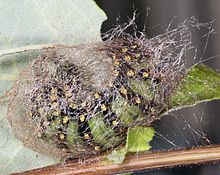Small peacock butterfly
| Small peacock butterfly | ||||||||||||
|---|---|---|---|---|---|---|---|---|---|---|---|---|

Lesser night peacock butterfly (male) ( Saturnia pavonia ) |
||||||||||||
| Systematics | ||||||||||||
|
||||||||||||
| Scientific name | ||||||||||||
| Saturnia pavonia | ||||||||||||
| ( Linnaeus , 1758) |

The Small Emperor Moth ( Saturnia pavonia ) is a butterfly of the family of saturniidae (Saturniidae). The species was voted Butterfly of the Year 2012 by the Bund NRW Nature Conservation Foundation and the Working Group of Rheinisch-Westphalian Lepidopterists .
description
The moths reach a wingspan of 60 to 85 millimeters. The males have gray and pink colored forewings, each with a dark eye spot with a yellow ring in the middle. There is a white field around it. The outer edge of the wing is dark gray with a white border behind it. This is followed by a broad, dark gray horizontal line, which is delimited towards the middle of the wing by a light, finely black edged, wavy band. Another band separates the first from the second third of the wing. It is dark and pink towards the base of the wings. The wing tips are also colored pink. The hind wings of the males are patterned like those of the forewings, only they have a yellow-orange basic color. The males have large, combed antennae .
The females have the same pattern as the males, but white and gray as the basic wing colors of both pairs of wings and on the forewings only the tips and the two bands that roughly thirds the wings are colored slightly pink.
The caterpillars are approx. 60 millimeters long and are initially black in color, then get orange spots on the sides and turn more and more green as they age. When fully grown, they are either completely green or green with black rings. You will then have pink or yellow colored warts from which a few black hairs grow. The young caterpillars have thick, black hairs.
Similar species
- Viennese night peacock butterfly ( Saturnia pyri )
- Saturnia pavoniella
- Middle peacock butterfly ( Saturnia spini )
Subspecies
- Saturnia pavonia pavonia ( Linnaeus , 1768)
- Saturnia pavonia josephinae ( Schawerda , 1924) The status of this subspecies has not yet been clarified, presumably it is a separate species.
Occurrence
The animals are found in large parts of Europe , east to Siberia . They are widespread far to the north, in the south the limit of distribution runs through northern Spain , north of the Alps through Slovakia , Kazakhstan and the Caucasus . They live in open areas with overgrown bushes and in sparse forests . They are widespread in Central Europe and are common almost everywhere.
Way of life
The moths have no mouthparts and can therefore only live for a few days. Their existence is limited solely to procreation. The males are diurnal, in contrast to the nocturnal females. The former find their sexual partners through attractants sent by the female, which they can smell for miles with their large antennae. Since the females only sit during the day and do not fly away, their location is only a matter of time.
Flight times
The moths fly between April and May, only for about a week.
Food of the caterpillars
The caterpillars feed on a large number of different plants, but have a preference for the foliage of the woody rose family (Rosaceae). Some food plants are blackthorn ( Prunus spinosa ), apple tree ( Malus domestica ), goat willow ( Salix caprea ), raspberry ( Rubus idaeus ), blackberry ( Rubus fruticosus ), blueberry ( Vaccinium myrtillus ), heather ( Calluna vulgaris ) and Meadow Sage ( Salvia pratensis ) .
development
The females lay their oval, ocher-colored eggs in ring-shaped clutches around small branches of the forage plants. The caterpillars that hatch from it pupate in a very firm, brown and egg-shaped cocoon . At one end, a trap made of rigid bristles is placed behind a round opening. Enemies cannot penetrate through these, but the fully developed butterflies hatch easily. The pupae overwinter, sometimes several times before they hatch.
swell
Individual evidence
- ↑ Butterfly of the year 2012
- ↑ a b c d e f g Heiko Bellmann : The new Kosmos butterfly guide. Butterflies, caterpillars and forage plants. Franckh-Kosmos, Stuttgart 2003, ISBN 3-440-09330-1 , p. 86f.
- ↑ Saturnia (Eudia) pavonia pavonia (Linnaeus 1758). Fauna Europaea, Version 1.3, April 19, 2007 , accessed on October 18, 2007 .
- ↑ Saturnia (Eudia) pavonia josephinae (Scha Werda 1924). Fauna Europaea, Version 1.3, April 19, 2007 , accessed on October 18, 2007 .
- ↑ W. Bruer (2014): Clarification of the species status of Saturnia (Eudia) josephinae (SCHAWERDA, 1924), stat. rev., by breeding hybrids of male S. (E.) josephinae with females of other species of Saturnia (Eudia) (Lepidoptera: Saturniidae). - News from the Entomological Association Apollo NF 34 (4): 195-200.
- ↑ Saturnia josephinae (Schawerda, 1923) - Andalusian Small Night Peacock. Identification aid of the Lepiforum , accessed on July 20, 2016
- ^ Saturniidae of Europe. AR Pittaway, accessed August 28, 2007 .
literature
- Hans-Josef Weidemann, Jochen Köhler: Moths. Weirdos and hawkers. Naturbuch-Verlag, Augsburg 1996, ISBN 3-89440-128-1 .
- Manfred Koch : We determine butterflies. Volume 2: Bears, Spinners, Swarmers and Drills in Germany. 2nd, expanded edition. Neumann, Radebeul / Berlin 1964, DNB 452481929 .
- Günter Ebert (Ed.): The Butterflies of Baden-Württemberg Volume 4, Moths II (Bombycidae, Endromidae, Lasiocampidae, Lemoniidae, Saturniidae, Sphingidae, Drepanidae, Notodontidae, Dilobidae, Lymantriidae, Ctenuchidae, Nolidae). Ulmer Verlag Stuttgart 1994. ISBN 3-8001-3474-8
Web links
- Lepiforum e. V. Taxonomy and Photos
- www.schmetterling-raupe.de
- Moths and Butterflies of Europe and North Africa (English)
- Saturnia pavonia at Fauna Europaea
- Info brochure from the School Biology Center Hanover on the Little Peacock Butterfly (PDF; 5.5 MB)









